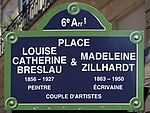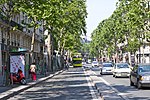Rue de Seine

Rue de Seine is a street in the 6th arrondissement of Paris. Rue de Seine is one of the most sought after streets in Paris due to its history and very close proximity to the Louvre and other famous Parisian landmarks.The rue de Seine and surrounding streets are host to the highest concentration of art galleries and antique dealers in the world.Other nearby famous landmarks include the Café de Flore, Les Deux Magots and the beautiful Jardin du Luxembourg. The neighbourhood of Rue de Seine also includes famous fashion houses, such as Dior, Yves Saint Laurent and Hugo Boss. The Hotel La Louisiane at 60 rue de Seine is famous for having accommodated many notable jazz musicians and writers, including Miles Davis, Chet Baker, John Coltrane, Ernest Hemingway, Jean-Paul Sartre and Simone de Beauvoir. Rue de Seine is the title of a 2006 album by Martial Solal and Dave Douglas.In the French novel La Duchesse de Langeais by Honoré de Balzac, the aristocratic character Marquess Armand de Montriveau lived in Rue de Seine. Rue de Seine is the theme and title of a poem by the famous French poet Jacques Prévert. It is also referenced by Julio Cortazar in the first paragraph of his novel Hopscotch (Rayuela). It is also famous for Guy Debord's 1953 anticapitalist graffiti Ne travaillez jamais (Don't ever work).
Excerpt from the Wikipedia article Rue de Seine (License: CC BY-SA 3.0, Authors, Images).Rue de Seine
Rue de Seine, Paris 6th Arrondissement (Paris)
Geographical coordinates (GPS) Address Phone number Website Nearby Places Show on map
Geographical coordinates (GPS)
| Latitude | Longitude |
|---|---|
| N 48.854166666667 ° | E 2.3369444444444 ° |
Address
Popelini
Rue de Seine
75006 Paris, 6th Arrondissement (Paris)
Ile-de-France, France
Open on Google Maps









